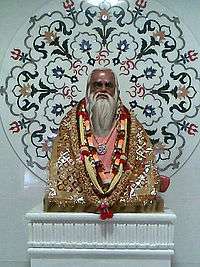Gagangiri Maharaj
| Gagangiri Maharaj | |
|---|---|
|
Gaganagiri Maharaj samadhi at Khopoli Ashram गगनगिरी महाराज | |
| Born |
Shripad Balasaheb Patankar Mandure, Patan, Maharashtra |
| Died |
4 February 2008 Khopoli, Raigad, Maharashtra |
| Nationality | Indian |
| Titles/honours | Vishva Gaurav |
Shri Gagangiri Maharaj is an Indian Guru of the Nath Sampradaya.
Life
Shri Gagangiri Maharaj (Marathi: गगनगिरी महाराज) was born as Shripad Patankar at Manadure Village in Patan district of South Maharashtra. At the age of seven, he left home and went to a Matha of Nath sampradaya which was located a relatively unknown place called Battees-Shirala. At a very early age he took Sannyasa.
After taking sannyasa he started travelling with Mahants of Nath Sampradaya. During pilgrimages he learnt yoga and several occult and religious practices. He travelled far and wide to places such as Nepal, Bhutan, Manas Sarovar, Gaurishankar, Gorakshdarbar, Gorakhpur, Pashupatinath and returned to Almora. Finally, he travelled through the Valley of Ganga, Himachal Pradesh and reached Badrika Ashram.
Gagangiri Maharaj was extremely tired as a result of his peregrinations and he decided to settle in a cave. When he was relaxing, a sage wearing saffron robes came there from the mountains. He sprinkled water from his kamandalu, on the face of Gagangiri Maharaj. He also gave him some kind of green grass to eat which resembled coriander leaves. For his penance, he had prepared mattresses of grass. He found his mattresses growing like living vegetation. This was considered as an experience, where Tantrik technique is perfected. He did a number of Kaya Kalpas. In this process he invented several new concepts in Tantrik techniques and proved them true. He did penance at a number of places like Mauli Kund, Mauli Kada, Zanzu water, Mausame Kada, Kasarbari, Ginger water, Sat-barkund, Holi Kada, Margaj water, Jungledeo patti, Shirale etc.
During monsoon, he stayed in the cave at Garbhagiri, Gagangiri. He did penance in a pond near the river at Sangashi, Vazar, Vesraf, Palsambe, Ramling etc. Later he went to Vijaydurg, in the Konkan area from where he reached Bombay by steamer. During 1945 to 1948, he did Kayakalpa at Angale, near Rajapur in Konkan. As more and more people benefited by his meditation, more and more people started worshipping and respecting him, and his reputation spread all around. In those days Ministers like Yeshvantrao Chavan, Balasaheb Desai, Rajarambapu Patil, Kapse and several respected officers used to worship him.
Swamiji then decided to move all over India alone on foot and accordingly his journey started. At this time, his fair skin was glowing with health. Attired in saffron robes of a sanyasi, he was revered by people. He travelled on foot from Haridwar to Delhi, Bhopal, etc. At Bhopal while he was taking rest after bath near a tank, the princely ruler of Kolhapur and his retinue happened to be nearby while on a brief visit. Swamiji's mother tongue being Marathi, a conversation between him and Kolhapur ruler's retinue ensued resulting in the Ruler requesting Swamiji to accompany him to Kolhapur. In 1932 the Raja of Kolhapur had been to Dajipur jungle for hunting. Swamiji who had accompanied him stayed back in the jungle, where he lived from 1932 to 1940. He spent these years in meditation and deep reflection.
In Bombay between 1948 to 1950, he stayed in Dadi Hirji Parsi graveyards, near the temple of Maruti, at shidi near Walkeshwar. Guru pournima (full moon day of Ashadha month for worshipping the Guru) used to be celebrated on a big scale at Birla Kreeda Kendra in Bombay,in spite of all these preoccupations in respect of the society/ he has continued his penance for over 60 years.
He used to travel between his ashrams in Khopoli and Gaganbawda. He has a huge number of devotees in Maharashtra, Madhya Pradesh, Gujarat, Karnataka and Andhra Pradesh. He had devotees like Dhirubhai Ambani, Bal Thakrae,Mamta Kulkarni.
Maharaj took samadhi on 4 February 2008 at his Khopoli Ashram.
External links
- www.gagangiri.org - Gagangiri Maharaj Official Website
- - Laksha Laksha Deepotsav Festival 2015 in Mumbai
- - Gurus - Extreme postures by Life Positive Article
- http://www.gurusfeet.com/guru/shri-mahayogi-gagangiri-maharaj - Gurusfeet.com Article
